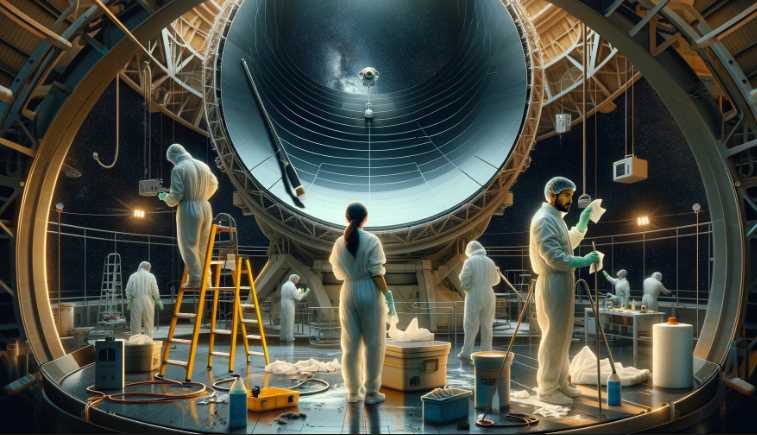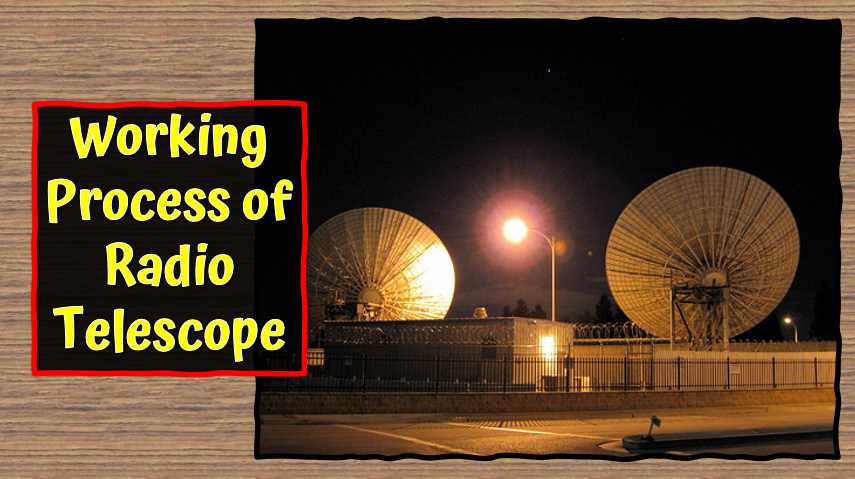As an avid stargazer, I’ve always been captivated by the mysteries of the universe. The realm beyond our planet holds secrets waiting to be uncovered, and one technological marvel that has played a pivotal role in unveiling these cosmic wonders is the radio telescope. In this article, we’ll delve into the intricate workings of these celestial detectives, exploring their significance and the breathtaking discoveries they have facilitated.
Scientists invented a radio telescope to collect radio waves and analyze them. Knowing all of the above, a deep curiosity in your mind is how does a radio telescope work? How has such a large telescope continued to contribute to science? Follow this article to learn how a radio telescope works; here, we have outlined the process understandably.
Basic Principles of Radio Telescopes

Electromagnetic Spectrum Overview
Understanding the fundamental principles of radio telescopes requires a grasp of the electromagnetic spectrum, an invisible orchestra of energy waves. From gamma rays to radio waves, this spectrum encompasses a vast range of frequencies, each revealing unique aspects of the universe. What sets radio telescopes apart is their specialization in the radio frequency range, typically spanning from a few kilohertz to several gigahertz.
Let’s break down the electromagnetic spectrum into its key components:
| Type of Wave | Frequency Range (Hz) |
|---|---|
| Gamma Rays | 10^19 – 10^24 |
| X-Rays | 10^16 – 10^19 |
| Ultraviolet | 10^14 – 10^16 |
| Optical | 4.3 x 10^14 – 7.5 x 10^14 |
| Infrared | 3 x 10^11 – 4.3 x 10^14 |
| Microwave | 10^9 – 10^11 |
| Radio | 10^3 – 10^9 |
The emphasis here is on the radio frequency range, where radio telescopes operate, opening a unique window to explore celestial phenomena.
How Radio Telescopes Collect Data
- Antenna Systems and Their Role: Imagine a radio telescope’s antenna system as a colossal ear tuned to the whispers of the cosmos. These antennas come in various shapes, with parabolic dishes being the most common. Their concave shape allows them to focus incoming radio waves onto a receiver situated at the dish’s focal point. The size of the dish is crucial; a larger dish captures more radio waves, enabling the detection of fainter signals.
- Signal Reception and Amplification: Once the antennas collect radio waves, the next crucial step involves signal reception and amplification. The collected signals are directed to a receiver, which typically includes a low-noise amplifier (LNA). This component plays a pivotal role in boosting the weak signals received from space, ensuring they are strong enough for further analysis.
Detection and Conversion
- Overview of Detectors: Radio telescopes employ various detectors to capture and measure the incoming radio waves. Bolometers, for instance, are sensitive devices that measure the heat generated when radio waves are absorbed. Masers (Microwave Amplification by Stimulated Emission of Radiation) are also utilized, acting as amplifiers to boost weak signals. These detectors serve as the telescope’s eyes, converting cosmic whispers into tangible data.
- Conversion of Radio Waves into Electrical Signals: The culmination of the process involves converting the detected radio waves into electrical signals. These signals, now amplified and enhanced, undergo further processing. The intricate dance of technology and physics transforms the analog signals into digital data, paving the way for astronomers to decode the language of the universe.
Main Parts of Radio telescope: What are the main parts of a radio telescope?
Before learning how a radio telescope works, you must know its main parts. Knowing the main features and their functions will make it easier to understand the working process of a radio telescope.
Antennas
- Parabolic Dish vs. Other Antenna Types: Radio telescopes, at their core, rely on antennas to capture and focus radio waves. The most iconic design is the parabolic dish, known for its ability to reflect and concentrate incoming signals. This design ensures optimal signal reception and enables the telescope to detect faint cosmic whispers. Other antenna types, such as dipole and horn antennas, cater to specific observational needs. Here’s a comparison of antenna types:Antenna TypeAdvantagesDisadvantagesParabolic DishExcellent signal focusing, suitable for faint signalsLimited field of view, complex maintenanceDipole AntennaSimple design, wide field of viewLess signal focusing, lower sensitivityHorn AntennaBroad bandwidth, versatileBulky design, challenging for precise aiming
- Design Considerations for Optimal Signal Reception: The design of a radio telescope’s antenna is critical for optimal signal reception. Factors such as the size of the dish, its surface accuracy, and the frequency range it covers impact its performance. Larger dishes capture more radio waves, enhancing sensitivity. Precision in surface construction ensures accurate signal reflection. Design considerations are tailored to the specific wavelength range a telescope aims to observe, making it a delicate balance between size, shape, and operational requirements.
Receivers
- Low Noise Amplifiers and Their Importance: Receivers in radio telescopes play a pivotal role in extracting meaningful data from the collected signals. Central to this is the low noise amplifier (LNA), a component that boosts weak signals while introducing minimal additional noise. LNAs are crucial for preserving the integrity of the faint signals received from space. Here’s a glimpse of the importance of LNAs in the signal chain:Without LNAWith LNASignal weakensSignal remains strong, noise minimizedGreater susceptibility to noiseImproved signal-to-noise ratio
- Frequency Filters and Signal Processing: Frequency filters within the receiver system help isolate specific bands of interest, allowing astronomers to focus on particular aspects of the electromagnetic spectrum. Signal processing then comes into play, where the raw data undergoes various stages of analysis. The combination of frequency filters and signal processing enhances the telescope’s ability to discriminate between cosmic signals and unwanted interference.
Data Processing Systems
- Role of Computers in Handling Vast Amounts of Data: The sheer volume of data collected by modern radio telescopes necessitates sophisticated data processing systems. Powerful computers are employed to handle the influx of information, enabling astronomers to sift through terabytes of data efficiently. These computers play a crucial role in real-time processing during observations and subsequent data analysis.
- Integration with Other Observatories and Databases: Radio telescopes are not solitary entities; they thrive on collaboration. Data collected is often shared and integrated with other observatories and databases worldwide. This collaborative approach enhances the scientific community’s ability to conduct comprehensive studies and cross-verify findings. Here’s a glimpse of the interconnected nature of radio astronomy:Observatory IntegrationBenefitsShared DataEnhanced scientific understandingCross-VerificationValidation of findings through multiple sourcesGlobal CollaborationAccelerated progress in astronomical research
Working Process of Radio Telescope
Observing Celestial Objects
- Target Selection and Tracking: The enchanting dance of a radio telescope begins with the meticulous process of selecting and tracking celestial objects. Astronomers carefully choose targets based on scientific objectives, whether it’s studying distant galaxies, pulsars, or enigmatic cosmic phenomena. The precision with which a telescope can lock onto a specific point in the sky is a testament to the advanced tracking systems in place.Celestial ObjectObservational ObjectiveDistant GalaxyStudying galactic evolution and dynamicsPulsarInvestigating neutron star propertiesGalactic CenterProbing the heart of our Milky Way
- Challenges of Radio Observation: Despite the marvels of modern technology, radio observation is not without its challenges. Earth’s atmosphere, while transparent to radio waves, introduces interference that can distort signals. Weather conditions, particularly precipitation, can further impact data quality. To mitigate these challenges, observatories are strategically located in regions with minimal atmospheric interference, and advanced signal processing techniques are employed to filter out unwanted noise.ChallengeMitigation StrategyAtmospheric InterferenceSite selection in radio-quiet zonesWeather ConditionsReal-time monitoring and data correctionSignal DistortionAdvanced signal processing algorithms
Imaging and Mapping
- Creating Detailed Radio Maps of Celestial Bodies: The magic unfolds as radio telescopes transform raw data into detailed maps, unveiling the radio emissions of celestial bodies. These maps provide astronomers with a visual representation of the intensity and distribution of radio signals. The process involves scanning the sky systematically and stitching together the data points to construct comprehensive images.Celestial BodyRadio Map ObjectiveOrion NebulaMapping molecular clouds and star-forming regionsCygnus A GalaxyInvestigating powerful radio jetsCrab PulsarStudying pulsar emissions and dynamics
- Multi-Wavelength Observations for Comprehensive Data: To unravel the complete story of celestial objects, radio telescopes often collaborate with observatories operating at different wavelengths, such as optical or X-ray telescopes. This multi-wavelength approach enhances the richness of the data and provides a holistic understanding of the observed phenomena.WavelengthObservational AdvantageOpticalCaptures visible light and details of structureX-rayReveals high-energy processes and emissionsInfraredPenetrates dust clouds, revealing hidden features
7 steps to follow

Step 1: Collecting Radio Waves
Dish antenna collects radio waves of different sizes. But since the radio waves are fragile and oversized, the dish surface is much larger.
Step 2: Reflecting the Radio Waves to Sub-reflector
The radio’s first waves come to the dish antenna. Since the dish surface is of parabolic shape, this curved shaped dish surface reflects the radio waves to the sub-reflector or secondary reflector.
Step 3: Reflecting the Radio Waves on the Feed Horn
After all the radio waves are reflected from the dish surface to the sub-reflectors, the curved sub-reflectors reflect these radio waves to the feed horn.
Step 4: Detecting the Radio Waves
After all the waves arrive at the feed horn, the feed horn detects the required radio waves from these radio waves. Every signal is not essential for the researchers. So, they attached a feed horn to a radio telescope to detect vital signs.
Step 5: Receiving the Radio Waves by the Receiver
These identified radio waves then go to the receiver. A radio telescope can have many receivers because the shapes or types of radio waves differ. There are separate receivers for collecting these different types of waves. Since radio waves are fragile, you need sensitive receivers.
Step 6: Recording
This time the radio telescope will record these stored radio waves. A radio telescope is a recording device that is attached to a computer. After the receiver receives the waves, it sends them to this recorder. The recorder records the waves and creates the required images.
Step 7: Analyzing
That is the last step. Here you will do the work of analysis. The primary purpose of using a radio telescope is done in this step. In other words, scientists invented the radio telescope for this step.
Advancements in Radio Telescope Technology
Single-Dish vs. Array Configurations
- Advantages and Limitations of Single-Dish Telescopes: Single-dish telescopes, characterized by a solitary large dish, have been instrumental in radio astronomy for decades. Their primary advantage lies in their simplicity and versatility. They are adept at observing large areas of the sky and are well-suited for surveying tasks.
However, these telescopes have limitations, particularly in terms of spatial resolution. The larger the dish, the better the resolution, but constructing extremely large dishes becomes impractical. Additionally, single-dish telescopes are susceptible to atmospheric interference. - Power of Interferometry in Array Configurations: The evolution of radio telescope technology has seen a paradigm shift towards array configurations, where multiple telescopes work in unison to act as a singular, powerful instrument. This technique, known as interferometry, enables astronomers to overcome the limitations of single-dish telescopes. By combining signals from multiple telescopes, interferometry enhances spatial resolution, providing unprecedented clarity in radio observations.
Radio Telescopes in Space
- Overview of Space-Based Radio Telescopes: The quest for clearer skies and an unobstructed view of the cosmos has propelled radio telescopes beyond Earth’s atmosphere. Space-based radio telescopes, such as the RadioAstron and the upcoming Square Kilometre Array (SKA) in space, offer unparalleled advantages. These telescopes operate above the interference caused by Earth’s atmosphere, providing a pristine environment for radio observations.
- Benefits and Challenges of Space Observatories: Space observatories present a myriad of benefits, including the elimination of atmospheric interference and the ability to observe a broader range of frequencies. However, these come at a cost. Deploying and maintaining instruments in space is a complex and expensive endeavor. Additionally, space-based telescopes have constraints on size and power, limiting the scale of the instruments.
Applications of Radio Telescopes
The applications of radio telescopes span a vast and diverse array of astronomical studies, contributing significantly to our understanding of the cosmos. As powerful tools in the realm of radio astronomy, these telescopes offer unique insights into various celestial phenomena. Here are some notable applications:
- Cosmology and Astrophysics: Radio telescopes play a crucial role in unraveling the mysteries of the universe at large scales. By observing cosmic microwave background radiation, the residual heat from the Big Bang, astronomers gain valuable insights into the early stages of our universe. Additionally, radio telescopes contribute to studying large-scale structures such as galaxy clusters, aiding in our understanding of cosmic evolution.
- Exoplanet Detection: The quest for habitable exoplanets is a forefront area of research, and radio telescopes contribute by detecting and characterizing these distant worlds. By observing the radio emissions associated with magnetic activity on exoplanets, astronomers can infer details about their atmospheres and potential habitability.
- Pulsar and Neutron Star Studies: Pulsars, rapidly rotating neutron stars, emit intense beams of radio waves. Radio telescopes are essential in studying these celestial lighthouses, allowing astronomers to probe extreme physical conditions and test theories of gravity. Pulsar timing observations, in particular, contribute to the detection of gravitational waves and the study of the fabric of spacetime.
- Mapping Galactic Magnetic Fields: Radio telescopes are instrumental in mapping the magnetic fields within our Milky Way and other galaxies. These maps provide crucial information about the interstellar medium, star formation processes, and the dynamics of cosmic structures. Observations of synchrotron radiation, emitted by charged particles spiraling in magnetic fields, help create detailed maps of these magnetic fields.
- Studying Active Galactic Nuclei (AGN): Active Galactic Nuclei, powered by supermassive black holes, emit intense radio waves. Radio telescopes contribute to the study of AGN, revealing details about the accretion processes, jets, and surrounding environments. This research aids in understanding the energetic processes that govern the behavior of these cosmic powerhouses.
- Astrochemistry and Molecules in Space: Radio telescopes enable astronomers to explore the chemistry of space by detecting radio emissions from molecules. These observations contribute to understanding the composition of interstellar clouds, star-forming regions, and even the organic molecules that serve as the building blocks of life.
What are the uses of the Radio telescope?

The radio telescope is an incredible invention for space research. Because of this, a significant change has occurred in space research. Scientists can now easily perceive different objects in the universe.
Radio astronomy is an excellent subject for school or university students. Learning to use a radio telescope is very important for radio astronomy. And these are the reasons why schools and universities use radio telescopes for radio astronomy.
Various science institutes use radio telescopes because radio telescopes play a vital role in learning astronomy.
Radio telescopes are used in museums or planetariums to attract the general public to astronomy. Here the radio telescope is set up so ordinary people can use it without skill.
What are the advantages of a radio telescope?
Clouds cannot interfere with the radio telescope’s signal collection because the radio waves that come to the antenna of the radio telescope are free from obstacles. The earth’s atmosphere can’t stop them.
You have known for so long that telescopes must be used in deep darkness during the day. Yes, you heard right; you should use your optical telescope only at night. But day and night are all the same for a radio telescope. Because you can use a radio telescope any time of the day or night, you will get equal performance at both times.
You know that pollution occurs in the universe at different times for various reasons; at this time, you can’t see with a standard optical telescope. But with a radio telescope, you can perceive space at any time because no pollution can prevent the observation of the radio telescope.
With a radio telescope, you can also see the star’s birthplace, the cold cloud of hydrogen gas. Clouds of cold hydrogen gas do not emit any visible light. But radio waves are generated so radio telescopes can collect them.
You would be surprised to know that a radio telescope can detect any hot object, such as hot gas, rotating next to black holes.
What are the disadvantages of a radio telescope?
The first bad aspect is that radio waves are fragile and have very low frequencies, which is why radio telescopes are so large. And because these waves are so weak, telescopes must be set up in uninhabited areas to collect them because the noise sinks the radio wave.
How much does a radio telescope cost?
The high-frequency dish antenna radio telescope is expensive. It costs around $500000. Too much, right? Yes, amateur astronomers do not use any radio telescope. Optical telescopes (Reflector telescope, Refractor telescope, Catadioptric telescope) are for everyday uses. Different astronomical research agencies use radio telescopes for their research purposes.
Final Words
These were the details about the radio telescope. Here we have tried what a radio telescope is and how it works. In summary, a radio telescope collects radio waves from the electromagnetic spectrum of an object through a dish antenna.
Its parabolic dish surface reflects the stored radio waves towards the secondary reflector. This secondary reflector reflects the waves at the feed horn, detects the feed horn waves, and sends them to the receiver. Then the analyzer analyzes the image.
Resources and References
- Thompson, A. R., Moran, J. M., & Swenson, Jr., G. W. (2001). “Interferometry and Synthesis in Radio Astronomy.”
- Kellermann, K. I. (2009). “New Horizons of Radio Astronomy in the Next Century.”
- National Radio Astronomy Observatory (NRAO): https://public.nrao.edu/
These resources provide in-depth insights into the principles, technologies, and applications of radio telescopes, offering a comprehensive foundation for further exploration.

I am an enthusiastic student of optics, so I may be biased when I say that optics is one of the most critical fields. It doesn’t matter what type of optics you are talking about – optics for astronomy, medicine, engineering, or pleasure – all types are essential.
Table of Contents

Pingback: HOW DO TELESCOPES WORK? BEST ARTICLE TO KNOW THE WORKING METHODS OF A TELESCOPE